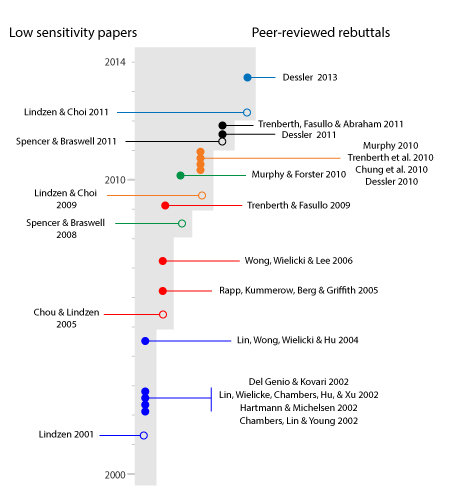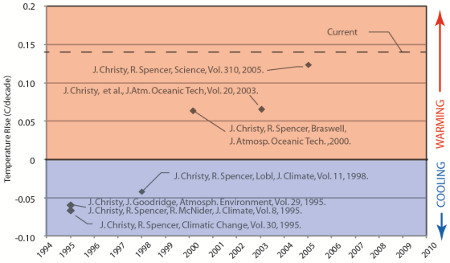by Dana Nuccitelli, "Climate Consensus - The 97%," The Guardian, April 11, 2014

Both the quality of mainstream and contrarian climate research and their media coverage have been unbalanced, but in different directions. Photograph: www.alamy.com
A new paper has been published in the journal Cosmopolis entitled "Review of the consensus and asymmetric quality of research on human-induced climate change." The paper was authored by John Abraham, myself, and our colleagues John Cook, John Fasullo, Peter Jacobs, and Scott Mandia. Each of the authors has experience in publishing peer-reviewed responses to flawed contrarian papers.
Despite the 97% expert consensus on human-caused global warmingsupported by peer-reviewed research, expert opinion, the IPCC reports, and National Academies of Science and other scientific organizations from around the world, a large segment of the population remains unconvinced on the issue. A new commentary by Edward Maibach, Teresa Myers and Anthony Leiserowitz in Earth's Future notes that most people don't know there is a scientific consensus about human-caused climate change, which undermines public engagement on the subject.
This 'consensus gap' is in large part due the media giving disproportionate coverage to climate contrarians. In our paper, we sought to evaluate whether that disproportionate media coverage was justified by examining how well contrarian hypotheses have withstood scientific scrutiny and the test of time. The short answer is, not well.
 Low climate sensitivity papers by Lindzen and Spencer (open circles) and peer-reviewed rebuttals (closed circles). Created by John Garrett of Wildomar, CA.
Low climate sensitivity papers by Lindzen and Spencer (open circles) and peer-reviewed rebuttals (closed circles). Created by John Garrett of Wildomar, CA.
The first contrarian argument examined in our paper was the claim that the Earth is not warming. This argument was particularly popular in the late 1990s and early 2000s, when John Christy and Roy Spencer from the University of Alabama at Huntsville published an analysis of satellite data that seemed to indicate the lower atmosphere was cooling. This appeared to contradict surface temperature measurements from thousands of thermometers around the world, which when combined together, indicated substantial global warming. Contrarians were certain that the thermometers were wrong, the satellites were right, and we didn't have to worry about global warming.
However, it turns out that satellite measurements of atmospheric temperatures are very tricky. The satellites are positioned above the atmosphere that they're trying to measure, and have to peer through many different atmospheric layers. Their orbits also drift, and satellites have limited lifespans, forcing scientists to splice together measurements from different instruments.
Gradually, various problems with the satellite temperature measurements were identified, some by the Huntsville group, and several by other groups. Corrections were made to the record, and before long the satellite record showed the warming of the lower atmosphere happening at a similar rate to that estimated from the thermometers around the globe.
 Evolution of lower tropospheric temperature trends from satellite observations.
Evolution of lower tropospheric temperature trends from satellite observations.
Two decades later, additional possible biases are still being identified in the satellite temperature record. Nevertheless, contrarians continue that the lower atmosphere isn't warming as fast as it should be, or that the surface thermometer measurements are biased hot (recent research has shown they actually have a cool bias). However, Christy and Spencer's claim that the planet isn't warming did not withstand scientific scrutiny or the test of time.
The second contrarian argument we investigated involved the claim that the global climate is not very sensitive to the increased greenhouse effect because the planet has some sort of natural climate response that will offset global warming. One of the first such arguments in the peer-reviewed literature was the 'infrared iris' hypothesis from contrarian darling Richard Lindzen.
The premise of Lindzen's hypothesis was that as the climate warms, the area in the atmosphere covered by high cirrus clouds will contract to allow more heat to escape into outer space, similar to the iris in a human eye contracting to allow less light to pass through the pupil in a brightly lit environment. However, within a year of Lindzen's iris hypothesis paper being published, four scientific groups had published their own studies finding significant flaws in his methods and assumptions, shown in dark blue in the first graphic above.
Several more critiques were published in the ensuing years failing to find evidence supporting the iris concept (red in the first graphic), showing that while the scientific community took this new hypothesis seriously, it simply failed to withstand scientific scrutiny. Although this is the case for most of Lindzen's arguments, he continues to be among the most highly sought contrarians by journalists and policymakers who try to create the perception of significant disagreement amongst climate science experts.
Roy Spencer and his colleague Danny Braswell have similarly published papers arguing that the climate is not as sensitive to the increased greenhouse effect as most climate scientists believe and most of the available evidence indicates. A paper they published in 2008 used a very simple climate model to make this argument, but subsequent research showed that their model was actually too simple, and failed to accurately represent how the global climate operates (green in the first graphic).
Spencer and Lindzen published several other papers making similar arguments in subsequent years, but these again failed to withstand scientific scrutiny (orange, black, and light blue in the first graphic). Various other scientific groups pointed out several flaws in the methods and assumptions in each of their publications, and in fact one editor resigned because he felt his journal had failed its task of conducting rigorous peer-review in publishing a fundamentally flawed 2011 Spencer and Braswell paper (black in the first graphic).
To contrast, human-caused global warming is based on solid fundamental physics that we've understood for over a century. In contrast to the relatively few studies mentioned here, thousands of studies have scrutinized and reaffirmed the basic physics that underlies the theory. It has withstood the test of time.
While there are still some areas of climate science undergoing serious research, like how much we're influencing changes in various types of extreme weather, the central tenets of human-caused global warming are solidly established. While some challenges have been advanced in the scientific literature, these challenges have been found to be incorrect.
In addition to the failure of their alternative hypotheses to withstand scientific scrutiny, research has shown that contrarian scientists have less expertise and fewer publications than mainstream climate scientists, and that as climate expertise increases, so does acceptance of human-caused global warming.
This then raises the question as to why contrarians are given disproportionate attention by the media and policymakers. They represent a small minority of experts with fringe views that have failed to convince the rest scientific community, simply because their ideas haven't withstood scientific scrutiny. On the other side we have human-caused global warming, supported by 97% of peer-reviewed research, expert opinion, fundamental physics, and having withstood the test of time. The fact that these two groups are treated as being on equal scientific footing and the issue continues to be 'debated' in the media has resulted in a misinformed public, and that's a problem.







No comments:
Post a Comment